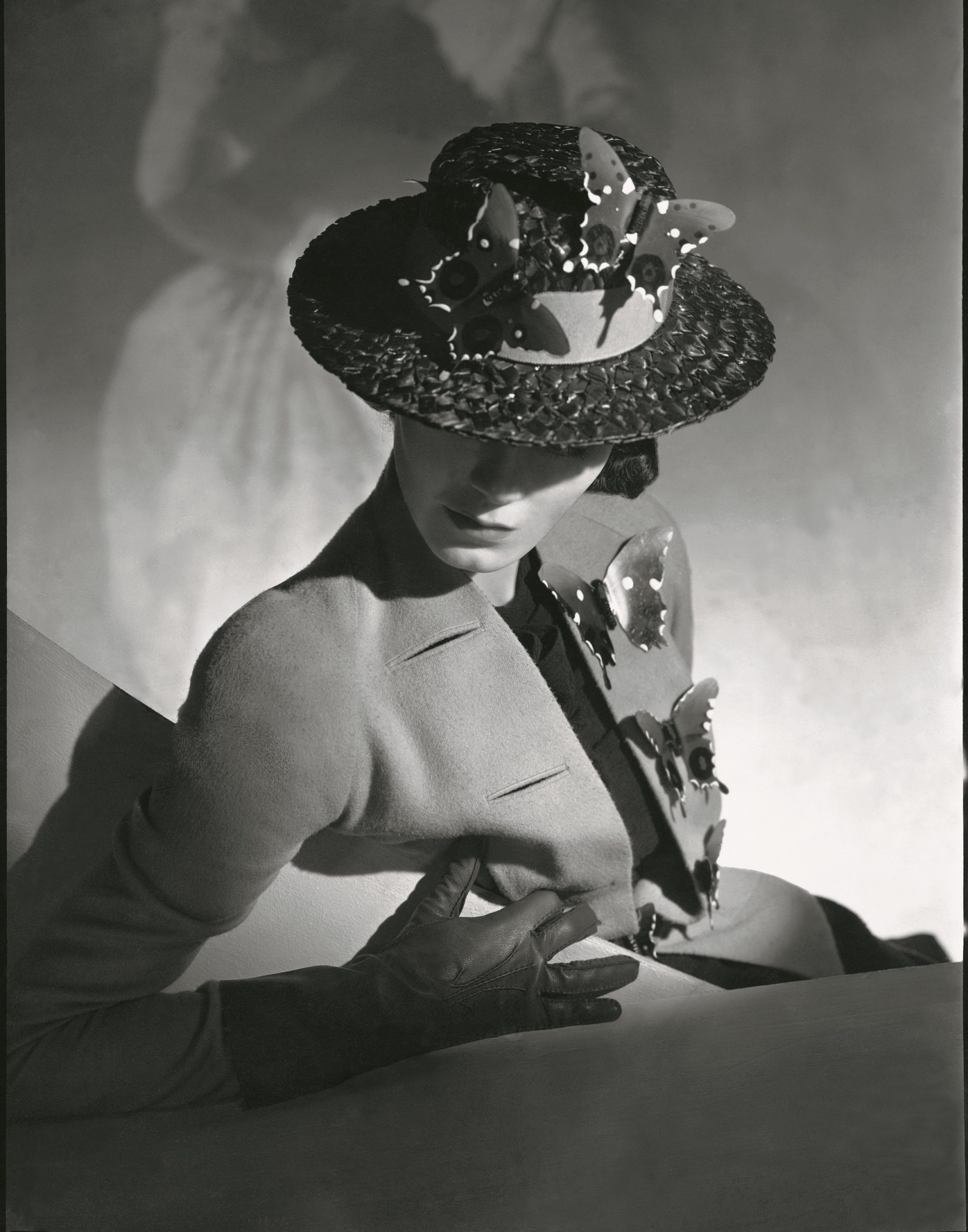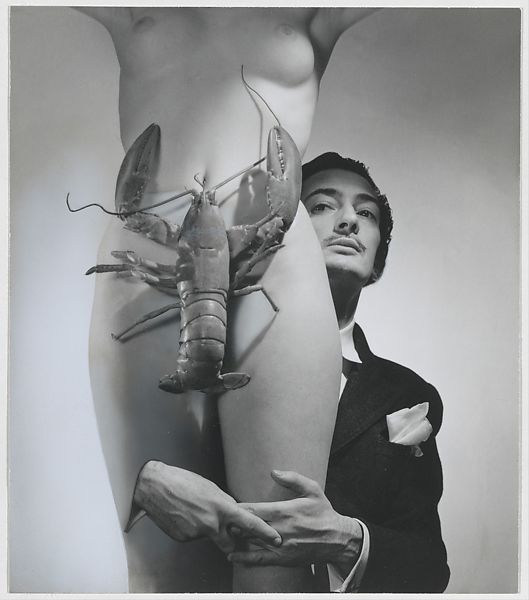VNEWS: Shocking! The Surreal World of Elsa Schiaparelli
On display at the Musée des Arts Décoratifs in Paris, the exhibition highlights the boundary-breaking legacy of the late Italian designer

This story appears in V137, available to order now
Lobster motif gowns, oblong diamond-encrusted necklaces, and top hats shaped like stilettos. No, this isn’t the plot of Moulin Rouge but rather the one-of-a-kind repertoire of Italian designer and couturier Elsa Schiaparelli. Jump-starting her career in Paris, Schiaparelli ran in circles with the likes of Salvador Dalí and Paul Poiret as her trompe-l’oeil separates and recognizable costume jewelry became the uniform for in-the-know Parisian women. Though the house shuttered its doors in 1954, its brilliance has been revitalized by current artistic director Daniel Roseberry. Now, Schiaparelli’s masterpieces come alive once again as the Parisian institution Musée des Arts Décoratifs unveils the retrospective exhibition Shocking! The Surreal World of Elsa Schiaparelli—just mere steps from where the house’s storied legacy began and two decades after the museum staged a retrospective on the creative.

Encompassing Schiaparelli’s dynamic breadth of work, the exhibition boasts nearly 300 silhouettes from the couturier’s archive and a slew of jewelry, sketches, ceramics, and more. “We wanted to not only show the audience—especially the younger visitors—the image of a legendary fashion designer, but make her alive as her work remains very modern,” Musée des Arts Décoratifs director and exhibition curator Olivier Gabet explains. “When you look at Schiaparelli’s designs from the late 1920s, they carry the spirit of that time.”
With Baroque-inspired outerwear placed alongside pre-war, cigarette-style trousers, visitors are guided chronologically, laying out Schiaparelli’s creative process and evolution as a sartorial force. Not only showcasing Schiaparelli’s personal repertoire, photographs by artistic forces like Man Ray, Salvador Dalí, and Jean Cocteau illustrate the forever bond between the arts and fashion. Like Schiaparelli’s ingenious work, the exhibition merges the surreal with the tangible, transporting onlookers to a realm of imagination and unfettered fantasy. “The main lesson from the exhibition is here you have a woman who, by herself, developed an incredible signature as a fashion designer,” Gabet says. “And her signature embraced everything: creativity, imagination. It was daring.”
Shocking! The Surreal World of Elsa Schiaparelli is on view at Musée des Arts Décoratifs July 6, 2022 through Jan 22, 2023.

Below, discover an extended Q&A with Musée des Arts Décoratifs director and exhibition curator Olivier Gabet!
V Magazine: How did the Musée des Arts Décoratifs decide to feature Elsa Schiaparelli and revisit her legacy in this exhibition?
Olivier Gabet: It was both easy and complex, we became very fortunate deriving this exhibition—you can expect Schiaparelli dresses, drawings, and more. On the other hand, which is quite complex, we wanted to borrow pieces that are very fragile. For us it was also a challenge to show these pieces to a new audience. The younger visitors have the image of Schiaparelli as a great fashion designer, a legendary figure. But we also wanted to make her very alive and modern, because when you look at Schiaparelli’s designs in the late 1920s, they bring the spirit of this time.
V: Can you explain the significance of the title of the exhibition: Shocking! The Surreal World of Elsa Schiaparelli?
OG: Very often Schiaparelli is associated with surrealism, but her designs are very modern [and] contemporary at a time when so many fashion designers wanted to underline artistic inspiration and collaboration. Someone like Elsa Schiaparelli was certainly a great fashion designer, but was also considered by many of her peers and friends as an artist by herself. And it’s very important to highlight this reality—inspiration, friendship with other artists, artwork. She had a talent to have other people work with her. And though today we are focused on collaboration, at the time, it was revolutionary. And that’s something we also want to underline in the exhibition. And it shows that the times have changed because often you have modern art and fine art exhibitions, but it is important today to make Schiaparelli appear as a real leader of the artistic movement.
V: In the exhibition, there are over 500 items ranging from clothing, accessories, perfume, and more. How did you go about the curatorial process in deciding what is included in the exhibition?
OG: The exhibition is a very comprehensive vision. But it was very important for us to make everything clear and intelligible for visitors to go through the museum without any idea about the history of fashion—it’s very, very important to make people feel comfortable. And the exhibition is a balance between chronology and reality about the life of a real woman: the way she evolved, where she comes from, what she does later, the way she organized her own collections. We also create moments where people can feel comfortable and understand what happened in the history of fashion: the ‘20s and ‘30s are a moment of great creativity in fashion, and though it barely appears on screens, we wanted to bring that vision to our visitors.
V: And can you describe how the exhibition is organized? What can audiences expect upon their visit to the exhibition?
OG: The exhibition was, more or less, approached in a chronological fashion. Though Schiaparelli may be less well known than other fashion designers, her background and work is made very clear in the exhibition. By showing Schiaparelli’s creations and nuances, the exhibition is a journey through the life, mind, and spirit of Schiaparelli. On the other hand, we also wanted to show the entirety of Schiaparelli because, beyond being a fashion designer, she had an amazing heart and always did the best with her work. That was one of the main focuses for the exhibition and curation.

V: Schiaparelli had a major infatuation with surrealism that blossomed in Paris. What did you learn about the life and practice of Schiaparelli upon staging this exhibition?
OG: What is interesting is that she was from a very different cultural background than other fashion designers at the time. She came from a very sophisticated family and grew up in the Palazzo Corsini in Italy, her father and uncle were great luminaries of Italian culture. And so she came from a very different background and was quite young when she arrived in Paris. She met Paul Poiret, a great fashion designer at the time. And she was collaborating with many artists during this time and it was so important for us to make people feel this in the exhibition. And it’s also one of the main parts of the exhibition, highlighting how she went from a very unique background to a very artistic reality.
V: What do you hope visitors of the exhibition gain about the work, life, and legacy of Schiaparelli?
OG: The main teaching is about creativity. And that’s very important today because you can be a wonderful marketer, you can be a merchandiser. But the main lesson for the exhibition is that: here you have a woman who, by herself, developed an incredible signature as a fashion designer. And her signature embraces everything—creativity, imagination. And with all of that creativity, for me, the main lesson is that you have to be tricky, you have to be creative to mark your time.

Discover More
